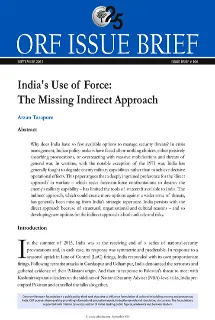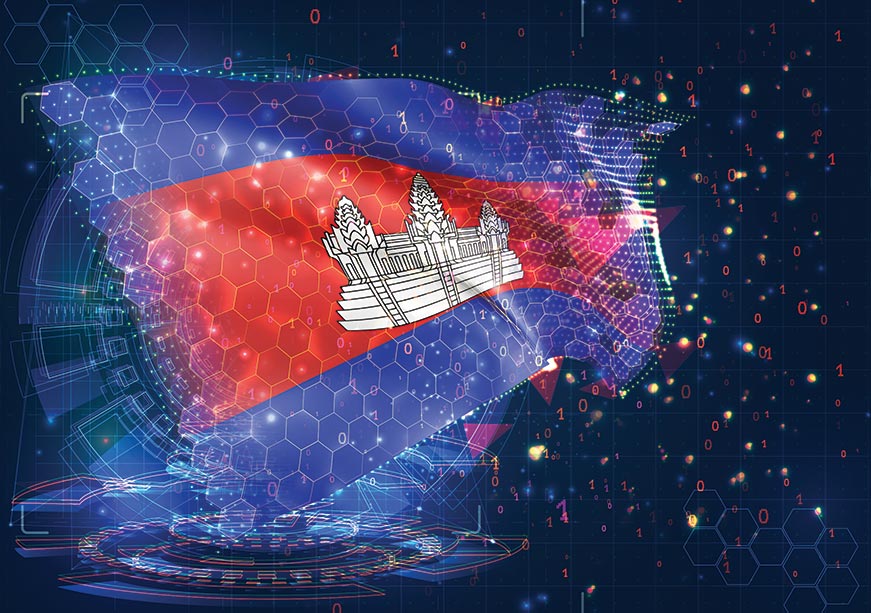Introduction
In the summer of 2015, India was at the receiving end of a series of national-security rovocations and, in each case, its response was symmetric and predictable. In response to a Iseasonal uptick in Line of Control (LoC) firings, India responded with its own proportionate firings. Following terrorist attacks in Gurdaspur and Udhampur, India denounced the terrorists and gathered evidence of their Pakistani origin. And then in response to Pakistan’s threat to meet with Kashmiri separatist leaders on the sidelines of National Security Adviser (NSA) level talks, India preempted Pakistan and cancelled the talks altogether.
This familiar cycle of Pakistani provocation and muted Indian response has become the baseline of security relations between the rivals. Occasionally, however, the pattern has been punctuated with the threat of general war. After the 2001 Parliament attack, for example, India mobilised its military for ten months, with the open threat of invading Pakistan along a broad front. Whether the provocation is small or large, India’s response has swung between stark binary choices: either continue diplomatic engagement in good faith, or suspend it; either maintain the peace, or start a general war.
Why does India have so few available options to manage security threats? India has often been praised for its ‘strategic restraint’ in eschewing war, such as after the major attacks of 2001 and 2008, and it undoubtedly displayed some forbearance in those cases. But its response was constrained not only by choice but also because it lacked useable military options. India has few available levers aside from the threat of general war with its neighbouring states. Even in war, India has few operational options aside from attritional conventional war. India has fought six wars since Independence, most of which exacted a high cost simply to maintain the status quo. In both crisis and war, Indian performance has suffered because of a lack of options.
This paper argues that a deeply ingrained preference for what is called the ‘direct approach’ in warfare has limited the tools of statecraft available to India, in the process compromising its war fighting and crisis management. The ‘indirect approach’, which could create more options against a wider array of threats, has generally been missing from India’s strategic repertoire. The arguments in this essay unfold in three parts. First, the paper explains the distinction between the direct and indirect approaches in warfare, and how India’s abiding preference for the direct approach has had adverse effects on how it has tackled its various crises and wars. Second, the essay outlines the reasons for such preference, showing how they are rooted in the structure and culture of India’s national security apparatus. Finally, the Brief closes by arguing that the prospect of India developing new force options is unlikely and carries its own risks for regional security.
The Direct Approach in India's Wars and Crises
The direct and indirect approaches denote different ways of war fighting. The direct approach seeks a force-on-force confrontation designed to physically destroy the enemy's military capabilities. It relies on mass, firepower, and conflict decision through battles to degrade the enemy's capacity to fight. In contrast, the indirect approach, as popularised by English military historian, Basil Liddell Hart, seeks to dislocate the enemy physically and, even more importantly, psychologically. It avoids costly forceon- force confrontations if possible, seeking instead to strike the enemy's weak points and support systems, with speed and surprise, until it feels compelled to capitulate.3 It can be used in conventional wars, when it relies on manoeuvre, as well as in unconventional conflicts or operations other than war, to coerce the enemy without engaging in open battle. Whereas the direct approach seeks to destroy the enemy's men and materiel, the indirect approach attacks the intangibles of the enemy's combat power – plans, command, cohesion, and morale. Any military activity will use a mix of direct and indirect methods, but campaigns usually emphasise one more than the other. India has traditionally favoured the direct approach.
India's approach to warfighting can be discerned from its history. Even in ancient times, some studies argue, India fought with a preference for overpowering mass in set-piece battle drills.4 Since Independence, India has fought six wars and displayed a preference for the direct approach in all of them except the 1971 war. In 1947-48, India responded to Pakistan's invasion of Jammu and Kashmir with a conventional defence and quickly reached a strategic stalemate, unable to surge more forces into the area of operations and unwilling to open a new front.5 In 1962, India fought a defensive war against China – its forces were poorly equipped and ineffective, and dispersed in fixed positions that were quickly defeated in detail.6 In 1965, India responded again to a Pakistani invasion in the west, and this time did open a new offensive front across the international border – but even that was a frontal attack on a wide front, with no concentration of force and no operational objective aside from destroying Pakistani forces.7 In Sri Lanka (1987-90), however, faced with a non-conventional conflict, India fought an overly conventional campaign, failing to adapt its ways to changed strategic conditions.8 Finally, in 1999, India again fought to repulse a Pakistani incursion, and in part because of self-imposed limits – such as not crossing the LoC – Indian forces were pressed into frontal assaults to recapture peaks one by one.9
The most notable exception to this historical pattern is the 1971 war.10 In that conflict, for months before the decisive conventional phase of operations, India worked closely with irregular militias to degrade enemy defences, and worked politically to shape international diplomatic opinion in favour of its intervention. In the decisive phase, India used highly mobile formations to bypass Pakistani defences and seize the East Wing's centre of gravity, Dhaka; Pakistani forces, disrupted by shaping operations and dislocated by the armoured onslaught, collapsed with little resistance.
In every war except 1971, India displayed a preference for the direct approach, seeking primarily to destroy enemy military capabilities. This enemy-centric approach, seeking to inflict pain rather than to achieve decisive operational effects, compromised India's wartime combat effectiveness. Using this approach, India often dissipated force, rather than concentrating it, reducing its forces' effectiveness either in defensive positions (such as in 1962) or in an offensive advances (such as in 1965). By focusing combat power on enemy forces (such as in 1947-48 and 1999), rather than on disrupting its support systems or attacking more vulnerable targets of value, India ceded the strategic initiative and incurred heavy tactical costs. And in all such cases – again, with the exception of 1971 – this approach yielded suboptimal outcomes for India; it fought reactively to restore the status quo, usually at great cost, and failed to proactively shape its security environment.
India's over-reliance on the direct approach compromised not only its military effectiveness in wartime, but also its crisis management. Without the more flexible strategic options offered by an indirect approach, Indian policy-makers have been left with only all-or-nothing options to coerce adversaries. In some cases, the absence of indirect options has resulted in Indian passivity. Thus regular Pakistan-sponsored terrorist attacks, most recently in Gurdaspur and Udhampur in the summer of 2015, reasonably lie below India's threshold for major military responses. India's small menu of impractical force options makes the country's passivity predictable, leaving it unable to deter future attacks, and allowing ongoing security threats to simmer unchecked.
In other cases, the absence of indirect options and the resulting all-or-nothing choice yields an Indian overreaction. Thus in the Brasstacks crisis of 1987 and Operation Parakram in 2001-02, India mobilised massive formations and wielded the threat of general war, from which it resiled in each case, after concluding that a general war would not be worth the political interests at stake.11 This approach to crisis management was 'direct' in that India threatened a general military confrontation for its own sake, with neither flexible force options, nor viable targets, and no apparent 'theory of victory' explaining how general military action would achieve specific strategic effects. This blunt and unimaginative application of the military instrument hobbled India's crisis management in at least three ways: it was predictable, and so it did not force Pakistan to concede or rethink its strategic calculus; it was escalatory, because in one step it took the crises to the brink of general war at short notice; and it was politically costly, because it left India with no alternative except to fight a war unwarranted by the interests at stake, or to back down. As these crises show, the absence of indirect options requires India either to passively absorb provocations, which undermines its deterrence, or to escalate massively by threatening general war, which undermines its credibility.
These fundamental strategic problems persist despite a new army doctrine, variously known as Cold Start or the proactive strategy.12 The new doctrine was designed primarily to overcome the cumbersome mobilisation processes revealed in Operation Parakram, and may have shortened deployment timelines. And although its concept of operations remains shrouded in official secrecy, the earmarked formations and publicly available information suggest it will not deviate too far from the enemy-centric attritional pedigree of the Indian Army. Cold Start's aim would still be to deploy massive force to threaten general war, with a broad and shallow offensive designed to inflict harm on the Pakistani military before political pressure forces New Delhi to cease the offensive. It thus perpetuates New Delhi's all-or-nothing choice; and perhaps partly for that reason, Cold Start remains untested, even after the highly provocative 2008 Mumbai attacks.
Thus India's current doctrine and force posture reinforce long-term patterns of privileging the direct approach. In crisis management, it forced India to make extreme all-or-nothing choices; in war, it has been costly and indecisive. In both war and crisis, with rare exception it has constrained India to defending a status quo that left underlying security problems unaddressed.
Why India Persists with the Direct Approach
On paper, some Indian capabilities and doctrine are designed specifically for manoeuvre warfare. The armoured units at the heart of its Strike Corps formations, for example, have always been theoretically earmarked for penetrating manoeuvre operations. But capabilities alone do not create force options or combat effectiveness. Despite having particular pieces of equipment or nominal mission sets, there are at least four reasons why India has failed to develop workable options using the indirect approach: India's power relative to its adversaries, civil-military relations, organisational culture, and a lack of strategic planning.
First, India's presumed advantages of power and mass over its adversaries has obviated the urgency for indirect approach options. Most of India's wars have been fought against militarily weaker opponents, and playing to its advantages, the simplest way to prevail should be to overwhelm the enemy with mass and firepower. The indirect approach is often favoured by smaller powers (such as Israel), because manoeuvre and risk-taking allows them to amplify the force they have; powers that can deploy overmatching mass have less need to develop such options. Even when India fought and lost against a stronger power – China in 1962 – its response was not to rethink its force posture or doctrine, but to grow the size of its military. Mass and firepower, not manoeuvre, have been India's solution to its military problems.
However, India's conventional advantages are in fact limited, as its record against Pakistan shows. Regardless of aggregate measures of national power, the local conventional balance in Kashmir or across the international border is much narrower.13 Thus in the attritional contests of 1947-48, 1965, and 1999, India failed to secure a decisive victory. Nuclear deterrence further erodes India's superiority, limiting the costs India would want to impose on Pakistan, even if it could. The preference for the direct approach thus rests on a presumed Indian material advantage that is, in fact, much weaker in reality.
Second, the disjuncture between India's military and political leadership distorts military planning in favour of direct methods. This civil-military rupture became stark after the 1962 debacle – when a chastised civilian leadership was blamed for the defeat – and reinforced once the 1965 and 1971 wars vindicated the civil-military separation. The services now jealously guard their operational autonomy, and the political leadership has wilfully abdicated its responsibility to provide direction.14 This institutional dysfunction allows the services to run their own acquisitions requirements, doctrines and plans, which favour firepower-intensive weapons acquisitions and large combat formations. Capabilities essential for manoeuvre operations and unconventional warfare – C4ISR, special operations, and air mobility – are neglected in favour of more traditionally prestigious combat arms such as armour and artillery. Their civilian masters, having failed to provide direction on their mission requirements, are left to face crises and wars with few useable force options except general war.
Third, the military services have a conservative and risk-averse culture that is poorly suited to manoeuvre operations. Manoeuvre is inherently more risky than static defences or set-piece battle drills. This risk is carried at all levels, from the tactical commander entrusted to execute the mission to the political leader leveraging the battlefield outcomes in peace negotiations. At every level, Indian organisational culture is particularly risk-averse; tactical commanders are not entrusted with mission command, and political leaders – cognizant of the political costs of having to concede ground in 1947-48, 1962, and 1965 – have been extremely sensitive to not endanger an inch of territory, regardless of any potential reward.
Finally, a lack of strategic and operational planning inhibits Indian force elements' ability to fight in anything but an attritional manner. To be effective, manoeuvre warfare requires astute military appreciation and planning – even if organisational culture bred Indian commanders to be riskacceptant, they need guidance to prioritise targets and achieve key effects. Without well-considered political goals, translated into viable military missions, Indian forces have little choice but to plan enemy-centric attritional campaigns. Thus despite a ten-month mobilisation in Operation Parakram, India never articulated what operational effects it sought, or how they would create desired political outcomes; echoing Indian behaviour in several wars past, New Delhi's aim seemed to be simply to threaten or inflict pain until political-diplomatic efforts arrived at a resolution to the conflict.15
New Options Unlikely and Risky
To date, India's investments in military and non-military instruments of power have not yielded the desired strategic dividends. India's military modernisation programmes have usually only strengthened or updated its existing options – newer tanks, guns, and fighter aircraft – reinforcing India's invidious all-or-nothing choices. Despite India's economic and military expansion, it will not be able to apply that growing power as long as it retains its preference for the direct approach. National Security Adviser Ajit Doval, for example, has repeatedly alluded to this, saying that India must stop punching below its weight and should respond appropriately to security provocations.16 What would new force options look like, and what are the prospects for India developing them?
Developing new force options is not a matter of simply acquiring new weapons systems, and there is no definitive set of 'indirect' capabilities. The same systems, capabilities, and organisations could be used for direct or indirect uses of force, and indeed India already has many of the tools that could be used for manoeuvre or unconventional operations. India has proven itself capable of such operations – for example, in 1988, India intervened at short notice to counter a coup d'etat attempt in the Maldives. India deployed force quickly and at great distance to secure the capital city and restore political order with minimal bloodshed. But such uses of force remain very rare; and military modernisation programs repeatedly neglect focusing on these types of capabilities.
Developing the indirect approach would mean refocusing military modernisation to emphasise certain capabilities over others, and designing missions that achieve specific operational effects. For example, to address its current gaps, India could develop more robust special operations capabilities for long-range strike or interdiction, clandestine intelligence operations and partnerships with irregular forces to disrupt militant networks, non-lethal options including cyber operations to disrupt enemy command and control, and information operations and more aggressive peacetime military diplomacy to leverage third-party support.
However, India remains unlikely to quickly develop such options. Regardless of new equipment acquisitions, its greatest hurdles will continue to be cultural and organisational, including its reluctance to embrace risk and mission command. Moreover, any doctrinal change would also be slow, because of sunk-costs biases and vested institutional interests in the status quo. Non-military options – such as covert paramilitary or political action – may be somewhat easier to develop because they would bypass the ponderous military bureaucracy. Indeed, National Security Adviser Doval himself has the Research and Analysis Wing as an action arm at his disposal. But even such operations would require careful preparation and long lead-times. There have been perennial rumours of Indian unconventional warfare activity, for example in Baluchistan, and the Indian press celebrated a special operations raid into Burma in June 2015. But for these activities to be a useful riposte to security provocations, they would need to either degrade militant capabilities (by targeting militant leaders or infrastructure), or deter the Pakistani state from sponsoring and deploying them, or at least satisfy the Indian domestic political constituency about improved domestic security. So even if the Indian government sought to develop this option, there is scant evidence that India would have the capacity to achieve strategic effects.
Developing such options would also have repercussions for regional security, both positive and negative. On one hand, Indian crisis management would be more scalable and flexible. Indirect military and non-military options would lend India options to coerce or deter its adversaries at the lower end of the conflict spectrum, using force in new ways, to surprise and dislocate the enemy without instantly embarking on a general war.
On the other hand, if India does develop new options to use the indirect approach, it may use force more often. In part this is because the creation of viable response options – especially if they are tested and proven – would generate even greater domestic political pressure to use them. Moreover, new options would not go unnoticed internationally – Pakistan may regard such developments as destabilising, triggering an action-reaction cycle of new and potentially riskier provocations. India cannot expect to develop new options and maintain the status quo. If India were to develop and use indirect methods in wartime, manoeuvre operations would be harder to control centrally, to limit escalation. Although India could seek to limit the war by deploying smaller force elements, skilful manoeuvre operations could still pose a potent strategic threat to Pakistan and trigger escalation, regardless of the size of the Indian manoeuvre element.
Politically, greater emphasis on the indirect approach could endanger India's prized moral high ground. India has been able to leverage its lauded 'strategic restraint' to emerge as a responsible great power; more frequent threats and use of force would challenge that image it has cultivated before the international community. Thus, weighing the direct and indirect approaches is not simply a technical military matter – like all strategic issues, it is deeply imbued with political meaning. The way India fights wars and manages crises has been fairly consistent for decades; a greater emphasis on the indirect approach would represent a policy shift with serious implications not only for regional security, but also India's national political character.
Endnotes
1. The author wishes to thank Manoj Joshi, Rajesh Rajagopalan, and Sushant Singh for comments on an earlier draft of this paper.
2. A similar point is made by Rajesh Rajagopalan, “Talking and Fighting with Pakistan,” Analysis, Observer Research Foundation, 22 August 2015, http://www.orfonline.org/cms/sites/orfonline/modules/analysis/ AnalysisDetail.html?cmaid=86998&mmacmaid=86999.
3. On the direct and indirect approaches to war, see , and on manoeuvre warfare, see J. J. A. Wallace, “Manoeuvre Theory in Operations Other Than War,” Journal of Strategic Studies 19:4 (1996).
4. For example, G. D. Bakshi, The Indian Art of War: The Mahabharata Paradigm (New Delhi: Sharada, 2002).
5. S. N. Prasad and Dharam Pal, History of Operations in Jammu and Kashmir (1947-48) (Dehra Dun: Natraj Publishers, 2005).
6. Neville Maxwell, India's China War (New Delhi: Natraj Publishers, [1970] 2015).
7. S. N. Prasad and U. P. Thapliyal, eds., The India-Pakistan War of 1965: A History (Dehra Dun: Natraj Publishers, 2011).
8. Harikat Singh, Intervention in Sri Lanka: The IPKF Experience Retold (Manohar Publishers: 2007).
9. Peter Lavoy, ed., Asymmetric Warfare in South Asia: The Causes and Consequence of the Kargil Conflict (Cambridge University Press, 2014).
10. S. N. Prasad and U. P. Thapliyal, eds., The India-Pakistan War of 1971: A History (Dehra Dun: Natraj Publishers, 2014).
11. P. R. Chari, Pervaiz Iqbal Cheema, and Stephen P. Cohen, Four Crises and a Peace Process: American Engagement in South Asia (New Delhi: HarperCollins, 2008).
12. For an overview, see Walter C. Ladwig III, “A Cold Start for Hot Wars?: The Indian Army's New Limited War Doctrine,” International Security 32:3 (2007/08).
13. Walter C. Ladwig III, “Indian Military Modernization and Conventional Deterrence in South Asia,” Journal of Strategic Studies 38:5 (2015).
14. Srinath Raghavan, “Civil-Military Relations in India: The China Crisis and After,” Journal of Strategic Studies 32:1 (2009), and Sunil Dasgupta, “The Indian Army and the Problem of Military Change,” in Swarna Rajagopalan, ed., Security and South Asia: Ideas, Institutions and Initiatives (New Delhi: Routledge, 2006).
15. V. K. Sood and Pravin Sawhney, Operation Parakram: The War Unfinished (New Delhi: Sage Publications, 2003).
16. Srinath Rao, “NSA Ajit Doval underlines use of power: India should stop punching below its weight,” Indian Express, 5 August 2015.
The views expressed above belong to the author(s). ORF research and analyses now available on Telegram! Click here to access our curated content — blogs, longforms and interviews.

 PDF Download
PDF Download



 PREV
PREV


